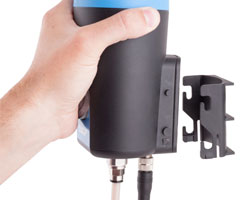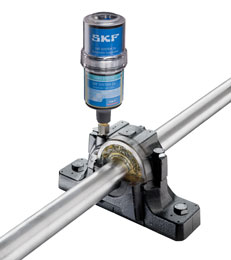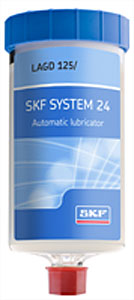The Five 'Rs' of Machine Lubrication
Lubrication is an essential part of machinery maintenance for nearly every production facility. On average, lubricant purchases amount to only 3 percent of a maintenance budget, but lubrication related activities can influence an estimated 40 percent of total maintenance costs.
The starting point of an effective lubrication programme is the detailed mapping of all machine lubrication points–their working conditions, lubrication requirements and criticality. This information is needed to select the most suitable lubricant, quantity of lubricant needed and to calculate the adequate re-lubrication intervals. These are the first three ‘Rs’ of lubrication.
In order to achieve optimum reliability and maximum benefits from a lubrication Programme, several factors need to be taken into account. These factors are summarised by the well known ‘five R’s’ of lubrication:
- The right lubricant
- In the right quantity
- At the right time
- At the right point
- With the right method
The fourth ‘R’ refers to best practices – tagging, colour coding (or other methodology) of both lubrication points and tools in order to avoid cross contamination. The fifth ‘R’ can be defined once the application conditions, asset criticality and maintenance strategy are analysed. This will help make the decision on whether to lubricate manually or use automatic lubrication. In order to make that decision, the pros and cons of automatic lubrication should also be understood and considered. Once the five ‘Rs’ are defined, the outcome will provide an answer to the key Question: “What is the best we can do to lubricate this component in the best way with the resources available?”
The Maintenance Strategy
The maturity level of a maintenance programme (corrective, preventive, predictive) will dictate the skill and knowledge levels required of personnel involved in lubrication related activities.
Factors affecting the fifth ‘R’
Criticality Analysis A thorough criticality analysis of each asset illustrates the impact of a failure in terms of:
- Overall production cost
- Overall maintenance cost
- Environmental impact
- Health and safety of personnel
The most critical assets are commonly the first targets of automatic lubrication.
As the maturity of maintenance and associated lubrication programmes increases, so does the complexity of tasks that lubrication technicians must be trained and capable of completing. These include activities such as:
- Lubricant analysis
- Lubrication routes continuous adjustment
- Re-lubrication intervals according with predictive techniques (lubricant analysis, vibration, thermography, etc)
- Lubricants consolidation
- Contamination control and fluid reconditioning
- Inspection routes
Therefore, as more mature maintenance programmes are adopted, the areas where skilled maintenance technicians can add value to your operations need to be carefully considered.
Benefits of Automated Lubrication for Bearings
Reduced waste and risk of bearing failure
Re-lubrication quantities are dictated by the physical space available in the bearing, and re-lubrication intervals are dictated by the working conditions that determine the degradation rate of the lubricant (speed, load, temperature, type of bearing, etc.) A single-point automatic lubrication system will deliver the right amount of grease at the right time to each lubrication point. This reduces both grease wastage and the risk of bearing failure.
 Cleanliness
Cleanliness
Lubricant contamination will also affect bearing life and increase risk of failure. In manual lubrication programmes, avoiding grease contamination can be a challenge.
Processes must be clean to ensure no external contamination ingress to the grease, and each lubrication point must have a cap on its grease fitting.
A properly installed single-point automatic lubricator will supply a correctly timed and accurate flow of fresh and clean lubricant, keeping the application in proper condition, while at the same time preventing contaminant ingress.
Labour saving
 Certainly, the simple manual task of pushing a lever on a grease gun to provide manual lubrication can be easily replaced by a machine. However, as highlighted in our discussion about the maturity of your maintenance strategy, the real question is: are you getting the maximum value from your skilled maintenance technicians? Such personnel can manage a lubrication programme through:
Certainly, the simple manual task of pushing a lever on a grease gun to provide manual lubrication can be easily replaced by a machine. However, as highlighted in our discussion about the maturity of your maintenance strategy, the real question is: are you getting the maximum value from your skilled maintenance technicians? Such personnel can manage a lubrication programme through:
- Continuous improvement of the lubrication routes (refinement of the 5 Rs)
- Implementation of a lubricant analysis programme
- Implementation of a contamination control and oil reconditioning programme
- Implementation of a leakage control programme
Deploying automatic lubrication systems can free them from time consuming basic activities to deliver that extra value.
Environment Health and Safety
A complementary perspective arises when considering the impact of improper re-lubrication activities on the environment. Consider again the grease waste calculations in the example above. Now try to estimate the impact of this waste on the environment. Naturally it depends on the disposal practices you have implemented at your facilities, but in basic environmental terms, this is simple: the less waste, the better.
Additionally, consider points of difficult or even hazardous access and the potential impact to your personnel. This is another area where automatic lubrication systems offer real benefits.
Typical Problems that Jeopardise the Benefits
The mere fact of using technology and automation doesn’t guarantee complete success by itself. Technology must be considered simply as an instrument to achieve a goal. Basic decisions and activities still must be performed. The following are typical mistakes that can jeopardise the potential benefits of deploying automatic lubrication.
Install and forget
Having an automatic lubrication device doesn’t mean that the system won’t require any inspection. Regular inspection will help deliver the best results from an automated system. Inspection will help identify installation issues (damaged fittings, leaking or blocked pipes, lubricators not dispensing at the right pace, etc.), and spot when its time to change or refill lubricants. As a result, inspection is required at an adequate frequency.
Use any grease without considering the application
 As a fundamental in any lubrication programme, the lubricant selection must precede the lubrication system selection. After all, the lubricant that goes into the application is what lubricates, not the delivery system itself.
As a fundamental in any lubrication programme, the lubricant selection must precede the lubrication system selection. After all, the lubricant that goes into the application is what lubricates, not the delivery system itself.
The lubricant and the automatic lubrication device must complement each other and ensure a better overall performance. Needless to say, not all lubricants are suitable for all automatic lubrication systems, and conversely, the impact of a lubrication system on the structure of the lubricant depends on the technology of that given lubrication system.
Consequently, parameters like pumpability and oil separation must be taken into account when a given automatic lubrication system is to be installed. Furthermore, re-lubrication intervals must be defined in a way that prevents the lubricant from being stationary inside the lubrication ducts, especially when exposed to extreme temperatures that could promote premature degradation. Failure to understand and act on these issues can affect the performance and associated benefits of deploying an automatic lubrication system.
When Should You Use Automatic Lubrication?
Automatic lubrication is certainly not the solution to all your lubrication issues. It has to be properly understood to boost its potential benefits, and in many cases those benefits can be reduced by a lack of sufficient knowledge about the topic. There are solutions available in the market for each of your applications, and it is difficult to imagine that a critical application is not worth equipping with an automatic lubrication device.
